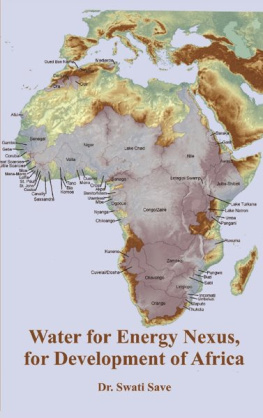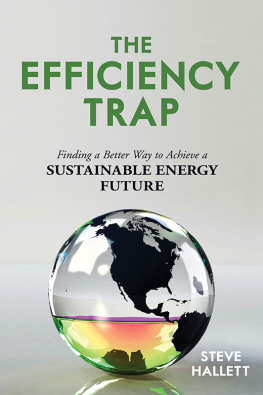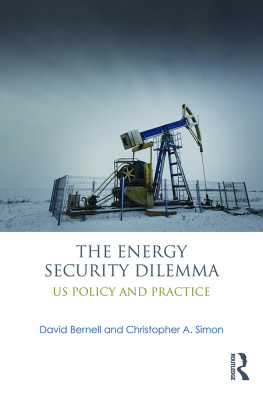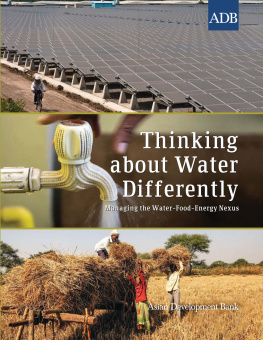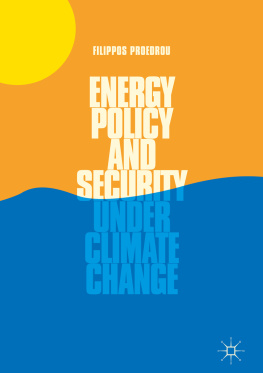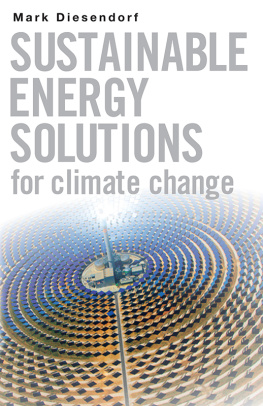Thirst for Power
Thirst for Power
Energy, Water, and Human Survival
Michael E. Webber

Published with assistance from the foundation established in memory of Henry Weldon Barnes of the Class of 1882, Yale College.
Copyright 2016 by Michael E. Webber.
All rights reserved.
This book may not be reproduced, in whole or in part, including illustrations, in any form (beyond that copying permitted by Sections 107 and 108 of the U.S. Copyright Law and except by reviewers for the public press), without written permission from the publishers.
Yale University Press books may be purchased in quantity for educational, business, or promotional use. For information, please e-mail sales.press@yale.edu (U.S. office) or sales@yaleup.co.uk (U.K. office).
Set in Bulmer type by Westchester Publishing Services, Danbury, Connecticut.
Printed in the United States of America.
ISBN 978-0-300-21246-4 (cloth: alk. paper)
Library of Congress Control Number: 2015950797
A catalogue record for this book is available from the British Library.
This paper meets the requirements of ANSI/NISO Z39.48-1992 (Permanence of Paper).
10 9 8 7 6 5 4 3 2 1
To Julia, Evelyn, David, Maverick, and future generations
ONE
Healthy, Wealthy, and Free
WHEN I TALK ABOUT GEORGIA in the same sentence with an undemocratic land grab from a neighboring territory, people often assume I am referring to the country formerly part of the Soviet Union. But Im notwater shortages can turn allies, even neighboring American states, into competitors. In 2008, the state of Georgia in the United States wanted land because it needed water: a year earlier various rivers dropped so low that the drought-stricken state was within a few weeks of shutting down its own nuclear plants. Water conditions had become so dire that the Georgia state legislature considered a resolution to move the states upper border a mile farther north, cutting across the Nickajack Reservoir to annex freshwater resources in Tennessee. The justification for the boundary adjustment was an allegedly faulty border survey from 1818. That is, Georgia was trying to use a two-hundred-year-old map to execute a land grab to capture some water that otherwise was under the control of Tennessee. One Tennessee state senator, recognizing the importance of American football in the southeastern United States, jokingly suggested that the dispute should be settled with a football game between rival schools in the two states. That attempt failed, but water remains contentious for those states and their neighbors. Since then Georgia, Alabama, and Florida have continued to battle, with multiple lawsuits and allegations. Drought is only one cause. A rapidly growing population, especially in Atlanta, as well as overdevelopment and a notorious lack of water planning, is running the regions rivers dry. Production of thirsty energy sources just exacerbates the situation.
It affected more than 620 million people, 9 percent of the worlds population. Although there were many reasons for the power outage, it was a lack of water that triggered the Indian collapse. A major drought in India that summer increased the demand for electricity at the same time that it reduced electricity production. Because of the drought, farmers increased their irrigation of crops using electric pumps. Those pumps, working furiously under the hot sun, increased the demand for power, straining the grid. At the same time, low water levels meant that power generation at hydroelectric dams was lower than normal, making it doubly hard for the power sector to meet summer demand. Even worse, floods earlier in the year had caused dams to silt up with runoff from farms, reducing their available capacity even before the low water levels made things worse. A double water whammy of flood then drought hobbled the hydroelectric dams. The result? A population larger than all of Europe and twice as large as the United States was plunged into darkness, with railways and other critical services brought to a sudden halt.
Energy and water are the worlds two most critical resources, but what many dont understand is even more significant: the two are intricately interconnected. They are like a hall of mirrors going on endlessly: energy needs water which needs energy which needs water... And strains in one can be crippling for the other with catastrophic consequences. In many ways, strains in the nexus of energy and water are our generations Cold Wara global crisis spanning decades that we need to solve or the future of humanity will look very different.
Virtually everywhere we look, signs of the extent of this crisis abound. The same summer of the blackout in India, a massive heat wave and record-setting drought swept across most of the United States, putting power plants in peril because cooling water was scarce or too hot to be effective. A few years earlier, the state of Florida made an unusual announcement: it would sue the U.S. Army Corps of Engineers over the Corps plan to reduce water flow from reservoirs in Georgia into the Apalachicola River, which runs through Florida from the Georgia-Alabama border.were concerned that the restricted flow would threaten certain endangered species. Regulators in Alabama also objected, worried about another species: nuclear power plants, which use enormous quantities of water, usually drawn from rivers and lakes, for cooling. The reduced flow raised the specter that the Farley Nuclear Plant near Dothan, Alabama, would need to shut down.
In California, two of its fabled nuclear reactors are sited on the coast between Los Angeles and San Diego. As one drives along I-5 between the cities, these nuclear reactors look surprisingly like two gigantic concrete breasts rising above the coast, just beside the highway and silhouetted by the ocean. Despite their evocative shape and their appealing, innocentsounding nameSONGS, which stands for San Onofre Nuclear Generating StationSoCal Edison announced that these plants would be shut down, partly because of water. Ongoing concerns that the nuclear power plants put ocean life at risk from entrainment of cooling water and the potential for radiation leaks that could contaminate the water along with other technical challenges became too burdensome to manage. It was easier to shut down the plant than to solve the radiation leaks and water problems to the satisfaction of the public.
Outside Las Vegas, Lake Mead, fed by the Colorado River, is now routinely one hundred feet lower than historic levels. As it stands, Las Vegas draws its drinking water from two straws that tap into Lake Mead. If the lake drops another fifty feet, the citys water supply will be threatened and the huge hydroelectric turbines inside Hoover Dam on the lake would provide little or no power, potentially putting the booming desert metropolis in the dark while leaving its occupants thirsty. Las Vegas solution is to spend nearly $1 billion on a third straw that goes deeper, coming from underneath and up into the lake from the bottom. But even that drastic solution might not work. Scientists at the Scripps Institution of Oceanography in La Jolla, California, have declared that Lake Mead could become dry by 2021 if the climate changes as expected and water users who depend on the Colorado River do not curtail their withdrawals. We can argue about whether the glass if half-full or half-empty, but an engineer will point out that the length of your straw does not matter if the glass is dry.
Communities in water-strained Texas and New Mexico, wary of the water risks posed by hydraulic fracturing for oil and gas production from shale formations, have imposed prohibitions or constraints on what water (if any) could be used for fuel extraction, even though the amount of water required by shale production is small compared with agriculture. Activists opposed to oil and gas production use concerns about possible water pollution as the rallying cry to halt increases in drilling.
Next page







